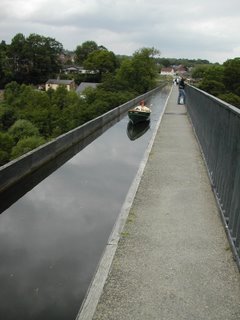

Built by Thomas Telford in 1795, the famous Pontcysyllte Aqueduct carries the Llangollen canal at a phenomenal height of 126 foot above the River Dee. Walking over it is an experience you remember. The moment you step out along the 1007ft chasm and look down, your legs feel like jelly and (at least in my case), the only way to reach the other side is to hang tightly onto the railing and fix one’s eyes on the other end.
The British Waterways Canal Guide writes enticingly that “the excitement to be derived from crossing this structure by boat is partly due to the fact that, while the towpath side is fenced off with, albeit widely spaced, iron railings, the offside of the canal is completely unprotected from about 12in above the water level.”
So, inspired by this, we drove up to Llangollen last weekend with our 17 foot Winsome pedal boat on the roof. We launched over the bank at Chirk and pedalled Winsome the 3 or 4 miles to Froncysyllte and on across the aqueduct to Trevor. We had a great time but the actual crossing of the aqueduct was slightly disappointing. It was certainly a far less thrilling experience than crossing by foot – in fact neither of us felt even the slightest hint of vertigo at all. We were left puzzling why this might be. Our conclusion was that, from the boat, we couldn’t look vertically down, only at an angle and that doesn't induce vertigo. It’s also possible that, by sitting in a boat, we didn’t have any of the usual fear of falling.
I tried to find some commentary on this effect on the Net but, so far, have only found a bunch of aircraft pilots swapping stories about their fear of heights. They are quite entertaining….
“Any kind of flying, I'm fine. That includes open cockpit microlights, gyroplanes which are like aerial motorbikes, and even hang gliding (though I never got beyond tethered flight). But I have trouble climbing ladders, and when I went tall ship sailing I absolutely refused to climb aloft to the crows nest. No-one could believe a pilot would be almost the only person who never went aloft even by the end of two weeks, but just looking at other people up there made me feel sick. Fear of falling? I don't know, but it makes more sense than anything else.”
“Bizarre. I thought it was just me! I can't bring myself to ride my bike over the Dartford Bridge (I can just about get myself to drive over in the car), yet the other day I was quite happily doing a tight turn over it at 1500' whilst looking down the wing and thinking 'there's that bridge I can't ride over'.”
Meanwhile, I wonder what swimming over the Pontcysyllte Aqueduct would feel like and whether anyone’s done it.




